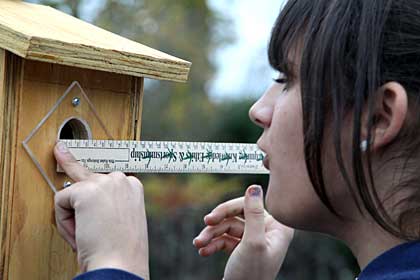Planting trees can be a lot of work as the second crop of Sonoma Valley High School students found out last month. As a part of Project GROW, the students are working to restore eight acres of oak woodlands at Audubon Canyon Ranch’s Bouverie Preserve in Glen Ellen. Christina Shriver teaches agriculture at SVHS and two of her classes – plant and soil science and lab biology – visit the preserve four times throughout the year to learn about habitat restoration from the biologists and specialists who steward Project GROW.
Project GROW is a unique partnership between ACR, the Southern Sonoma County Resource Conservation District and the Center for Land-based Learning’s Student and Landowner Education and Watershed Stewardship program. As part of this year’s program, the SVHS students, in addition to planting five species of oak acorns and buckeye seedlings, will also build and install nest boxes. The nest boxes provide habitat for small birds such as the Western Bluebird and Tree Swallow, who nest in cavities in oak woodlands.
I joined the students on a cold, misty day in November when they had first planted seedlings and then, after a hot lunch in the preserve’s cozy lodge, tramped outside again to learn about and install the nesting boxes. Jeanne Wirka, the resident biologist at the preserve, explained to the students that the nest box project adds animals to the oak restoration equation and that the boxes would act as “stand-ins” for mature habitat until the new trees grow.
“Cavity nesting birds are incredibly important to the oak woodland ecosystem and your efforts will help us keep them around until the oak trees mature,” said Wirka.
As the students installed the boxes they learned how to deter predators as well as hot to orient the opening to protect the boxes’ inhabitants from the elements. They also used a GPS device to record the position of the nest box, later uploading the information to a computer and posting it on the web site nestwatch.org. NestWatch is a continent-wide citizen-science project and nest-monitoring database of the Cornell Lab of Ornithology, funded by the National Science Foundation and developed in collaboration with the Smithsonian Migratory Bird Center. Using the site, researchers and the students can monitor the results of their work in the field.
Savannah U’Ren is a tenth-grade ag biology student who said that for her, the entire experience was “really cool.” “I’m into horses and animals and am thinking of becoming a domestic animal vet. This program is a great opportunity to explore what other options are available to me.”
The students will visit the preserve two more times during the school year – in January and April – to finish up their work. “This program gives students a sense of place. It allows them to connect with the land which is a very powerful thing,” said Susan Haydon, assistant district manager for the Southern Sonoma County Resource Conservation District. “The work they do at the preserve – planting trees and installing the nest boxes – will stand as a testament of their work for generations to come.”
Teacher Shriver couldn’t agree more. “This is a great experience for the students. The mentors are fabulous. They work in small groups with the kids and can really inspire them to think of careers outside the norm and, more importantly, the world around them. It’s a wonderful partnership.”
Photos by Melania Mahoney
[nggallery id=24]








Be First to Comment